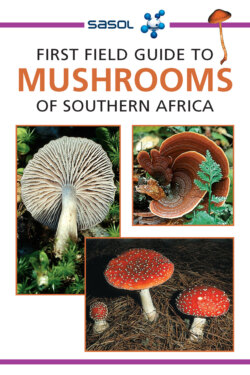Читать книгу First Field Guide to Mushrooms of Southern Africa - Margo Branch - Страница 11
На сайте Литреса книга снята с продажи.
Spores and spore prints
ОглавлениеThe microscopic spores are an important feature used by scientists to identify mushrooms. They are consistent in size, colour and shape for each mushroom species. Although spores are too small for field identification, a spore print can be taken, which allows one to see the colour of the spores and preserve them for further examination. To take a spore print, simply cut off the cap and place it with the gill or pore surface down on a piece of paper. Cover it with a glass and leave it for a few hours. Use dark paper if the spores are pale.
The shape of the pores and arrangement of the gills are also diagnostic features.
A spore print showing the colour of the spores and arrangement of gills.
Large dark spores of Shaggy Ink Cap, spindle-shaped spores of Pine Bolete, spiny white spores of Russula and light-brown spores of the Orange Tuft as seen through a microscope.
Undersurface view of the pores of the Pine Bolete (see page 43).
Undersurface of the Maze Gill, Daedalea quercina, a thick cork-like bracket fungus found on oaks.
